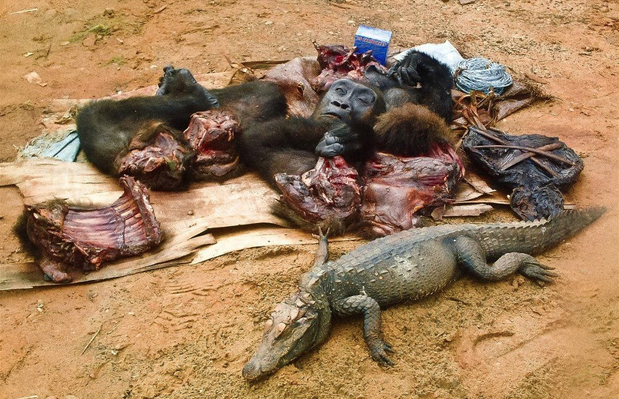The hunting of wildlife for bushmeat has become a “global crisis” that threatens to wipe out more than 300 species, or a quarter of all threatened terrestrial mammal species on Earth, a first-of-its-kind study released Wednesday warned.
This is the first global assessment of mammal hunting and results show evidence of a global crisis,” the authors wrote Wednesday in the journal Royal Society Open Science.
“Many forests, savannahs, grasslands, and deserts in the developing world are now becoming ‘empty landscapes,’ ” they added. “Only bold changes will substantially diminish the imminent possibility of humans consuming many of the world’s wild mammals to the point of functional or global extinction.”
Said study lead author William Ripple, distinguished professor of ecology at Oregon State University: “These were surprising results and alarming results. I wasn’t expecting to find so many species where the major threat is hunting. If we go ahead with business as usual, we’re going to have many regions suffering from a lack of animals.”
The species being pushed toward extinction by illegal and unregulated hunting include clouded leopards, tigers, Bactrian camels, long-beaked echidnas, and pangolins.
The International Union for Conservation of Nature lists one-fourth of the world’s roughly 4,500 land mammals as threatened with extinction. Ripple and his team analyzed individual species from the list and identified 301 threatened mammal species for which a primary threat is being shot or trapped by humans.
The main reason for the hunting is to obtain meat for food, followed by medicinal products, ornamental use, and the live-pet trade.
All of the species live in developing countries such as Madagascar, Indonesia, Philippines, Brazil, Papua New Guinea, India, and China.
Of the 301 species threatened by hunting, 126 primates were on the list. The other most-threatened species included hoofed animals, bats, marsupials, and carnivores.
“This group of heavily hunted mammals represents…approximately 7 percent of all assessed terrestrial mammals and approximately 26 percent of all threatened terrestrial mammal species on the Earth,” according to the study.
Just 2 percent of the mammals have populations that are stable or increasing. Among all the species endangered by hunting, on average only 10.5 percent of their ranges lie within protected areas.
The largest animals, those weighing more than 2,200 pounds, are most at risk of extinction.
“Humans have always taken the larger animals because they have more meat,” Ripple said. “But they are also fewer in number, so their risk for extinction is higher.”
Wildlife poaching is on the increase, fueled by rising human populations in developing countries, improved weaponry and transportation, and overseas demand for exotic bushmeat and other body parts trafficked by global criminal syndicates.
Bushmeat hunting not only depletes species but also threatens human health and economic well-being, said the researchers. Subsistence hunters must compete with commercial poachers, for example, creating food insecurity in some areas. Wildlife loss can drive away tourism, and infection from slaughtered animals has sparked deadly pandemics, including AIDS/HIV and Ebola.
The authors proposed “five conservation actions” to combat the problem, including enhanced law enforcement and increased penalties for poaching, special hunting rights for local communities so they will have a stake in conservation, alternative food sources, increased education and family planning, and changes in international policies to fight trafficking.
Huijbregts said governments could do more to stop trafficking.
There are only a few big roads in and out of wilderness areas, he noted. One method of deterrence would be “an intelligence system of roadblocks, with dedicated law enforcement and wildlife agencies using things like sniffer dogs—and not only confiscating the meat but other assets of the traders,” Huijbregts said.
Adam Roberts, chief executive of Born Free USA, said the research “confirms something that [we] have talked about for a very long time.”
“This paper shows the transition from what was historically subsistence hunting for food to a more commercial enterprise,” he said, “and the minute you start to monetize or commodify wildlife, you run the risk of wiping the animals out.”


